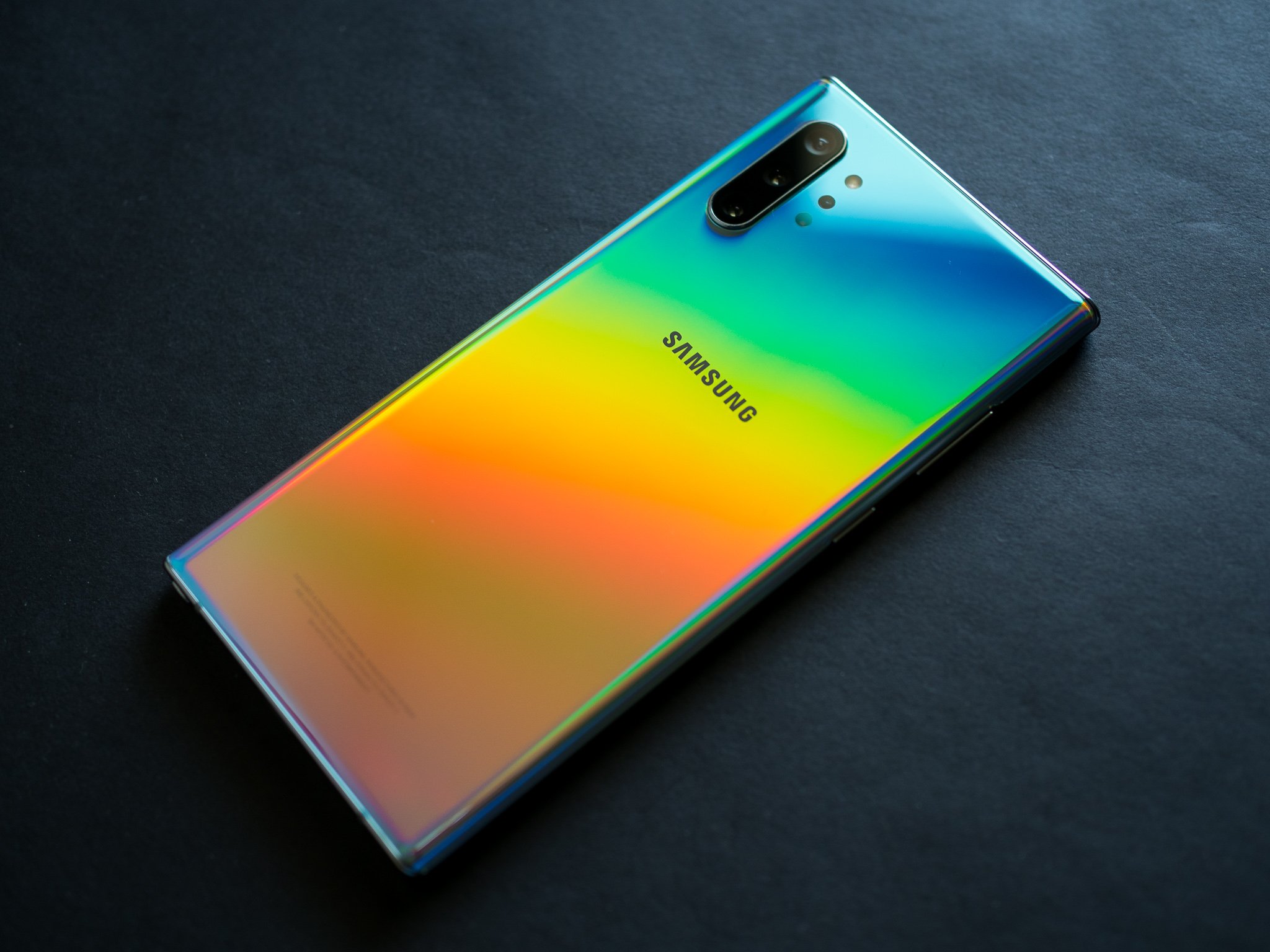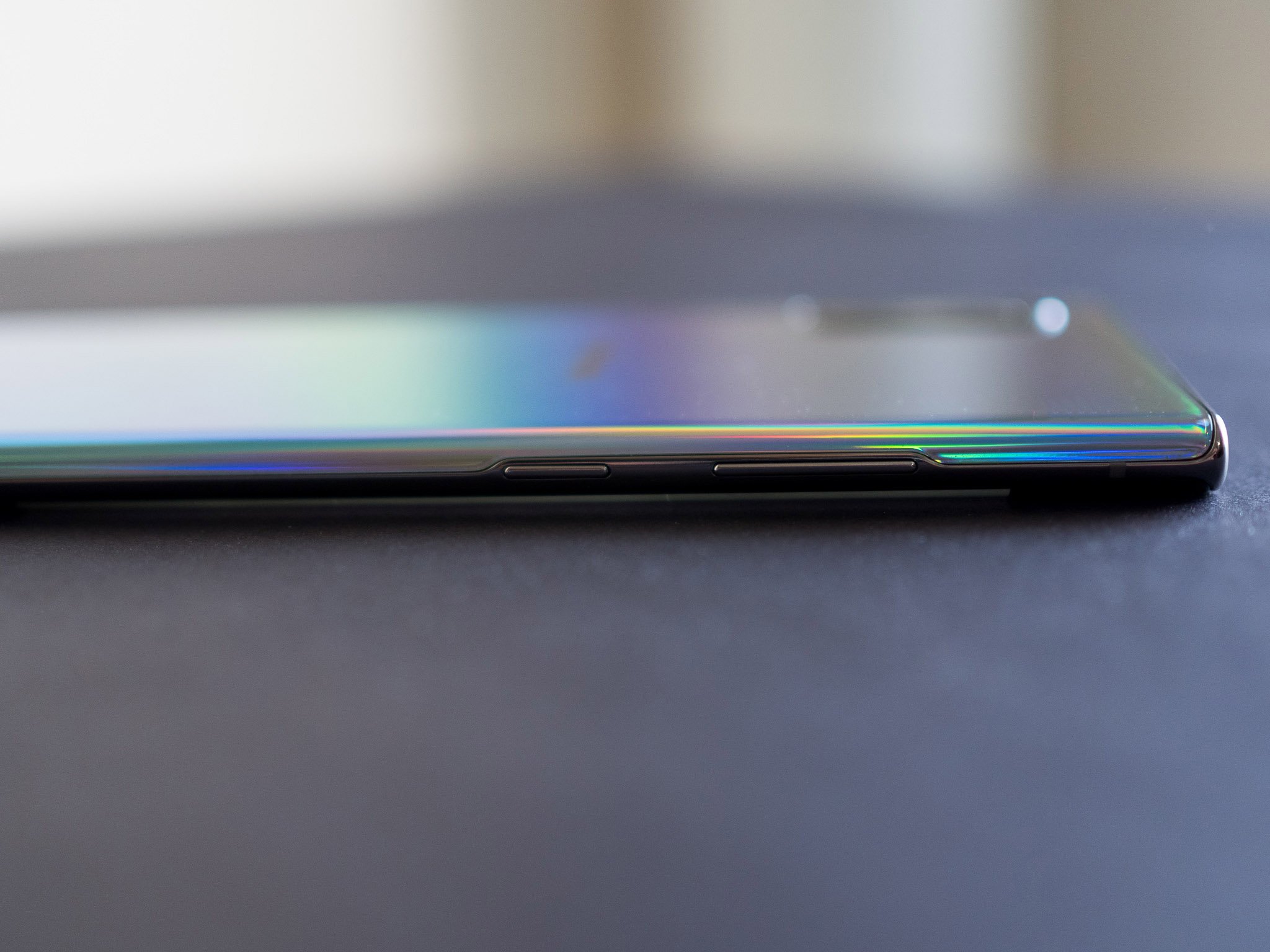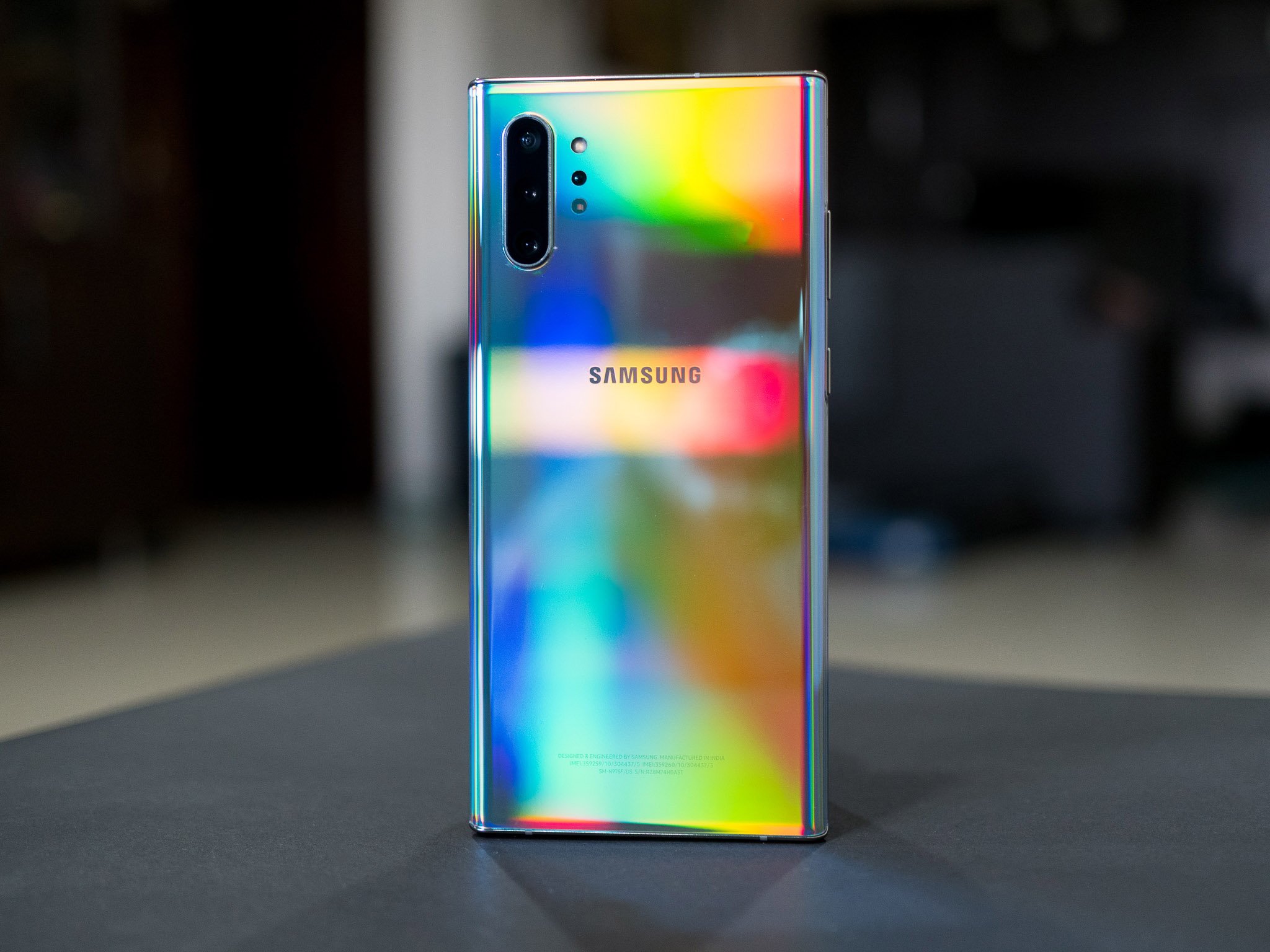
 Source: Harish Jonnalagadda/Android Central
Source: Harish Jonnalagadda/Android Central

 Source: Harish Jonnalagadda/Android Central
Source: Harish Jonnalagadda/Android Central
I’ll be frank: I wasn’t particularly interested in the Galaxy Note 10+ when it debuted four months ago. But once I started using the phone, I was immediately hooked. The Note 10+ doesn’t have a 90Hz panel or any groundbreaking new camera features, with Samsung choosing to focus on fast charging and design.
The gradient pattern makes the Note 10+ immediately stand out — it’s one of the prettiest phones Samsung has made to date — and the 45W fast charging combined with a massive 4300mAh battery lets you use it for longer. The S Pen has also picked up new features, and overall you get the best hardware money has to offer.
Samsung has delivered the Android 10 update to the phone at the end of December, bringing its latest UI refresh, One UI 2.0. The interface has meaningful updates that make it even better, and it’s astonishing to see how far Samsung has come in this area in the last two years. Here’s what I think of the Galaxy Note 10+ after four months of usage.
Bottom line: The Galaxy Note 10+ has all the features you care about. The large AMOLED panel sets the standard for the industry, the internal hardware is rock-solid, and you get reliable cameras, all-day battery life, and 45W fast charging. Combine that with regular software updates and new feature additions and it’s easy to see why the Note 10+ is one of the best phones around.

 Source: Harish Jonnalagadda/Android Central
Source: Harish Jonnalagadda/Android Central
One of the main reasons I use a Samsung flagship year after year is the AMOLED display. Like I said with the Galaxy Note 8 and last year’s Galaxy Note 9, Samsung continues to make sizeable gains in display quality with its Note series.
Sure, Samsung played it safe this year by going with a 60Hz panel instead of a 90Hz screen, but in terms of panel quality, there isn’t a phone today that comes close to the Note 10+. Interacting with the display on a day-to-day basis is an absolute delight — you get incredibly vibrant colors, excellent contrast levels, and great viewing angles. I’m not exaggerating when I say that this is the yardstick for mobile displays.
Samsung delivers an outstanding display year after year, and the Note 10+ continues that legacy.
Samsung also made significant changes to its design language with the Note 10+. Previous devices in the Note series leveraged Samsung’s industrial design, but they never really stood out. That isn’t the case with the Note 10+, with the Aura Glow edition one of the most vibrant designs you’ll find anywhere today.
The U.S. market doesn’t get the crazy designs that are common in Asia, but Samsung has done a masterful job with the gradient pattern on the Note 10+. The mesmerizing colors immediately grab your attention, and while they may not be to everyone’s tastes, I love what Samsung has done here. The Note 10+ is the widest and tallest phone I’ve used in a long time, and while it took a while to get used to the bulk, I liked using the giant 6.8-inch screen.
Another positive design change is the positioning of the front camera cutout. The Note 10+ has a single camera at the front, and the fact that it is centered makes it far less distracting. The positioning of the cutout also ensures that the status icons are no longer pushed to the right. It may not seem like a big deal, but it makes a huge difference in day-to-day usage. The cutout on the S10+ was plain distracting, and that’s not an issue on the Note 10+.
The Galaxy Note 10+ may not have many groundbreaking features, but Samsung’s ability to iterate and deliver marginally better features with every generation means you’re getting a robust phone here. There are no glaring hardware issues like you get on the Pixel 4 XL, and Samsung has made huge gains on the software front in 2019.
I switched away from the Note 10+ to use the Pixel 4 XL for a month, and returning to Samsung’s flagship it was easy to make out the hardware differences. When you’re spending this much money for a phone, you’d want a device that delivers when it comes to the basics. That’s absolutely true here: with 12GB of RAM as standard and 256GB of UFS 3.0 storage, the Note 10+ is a much better long-term investment. I was never anxious about the storage running out — which wasn’t the case with the Pixel 4 XL.
Continuing on the hardware theme, the in-screen fingerprint reader is great and I didn’t have any issues with it. It is fast to authenticate and reliable in day-to-day usage, and works well in conjunction with face unlock. Elsewhere, the stereo sound makes it highly enjoyable to play games and watch videos on the phone. The Note 10+ works particularly well for multimedia playback thanks to the large screen and vibrant colors.
Yes, you’re paying a premium for the Note 10+, but you’re getting the best hardware that’s available in the industry. With that comes the peace of mind that you’re getting a phone that will last several years with ease.
[embedded content]
Samsung rolled out the Android 10 update to the Note 10+ at the end of December, introducing a few new features and subtle tweaks to the user interface. One UI 2 is definitely a move in the right direction, and it’s great to see Samsung take user feedback seriously and make tangible gains in this area.
Samsung invested in its own gesture navigation system, and with One UI 2.0 you get the option of choosing between three styles: the legacy three-button layout, Samsung’s One UI 1.0 gestures, or the new Android 10 gestures. There’s also a native screen recorder, and Samsung is now using Android 10’s native system-wide dark mode, ensuring more apps work in dark mode automatically.
It took Samsung a few months to roll out the Android 10 update, but it has done a great job delivering monthly security updates and bug fixes.

 Source: Harish Jonnalagadda/Android Central
Source: Harish Jonnalagadda/Android Central
The differentiator for the Note series has been the S Pen, and on the Note 10+ the stylus has picked up even more features. I’ll be honest here; I didn’t use the S Pen with any regularity over the last four months. My usage was limited to two things: using it as a remote shutter button and switching between the front and rear cameras, and taking handwritten notes during product briefings. In both scenarios, the S Pen has worked flawlessly.
Another area that I haven’t had any issues with is battery life. The Note 10+ continues to deliver over a day’s worth of use without fail, and battery life, in general, has been reliable enough that I never had any anxiety about the device running out of juice before the end of the day. What’s particularly great is the fact that it now has 45W fast charging, and even though I routinely used 25W chargers with the phone, I was able to charge the device from flat to 100% in just over an hour, and that was more than enough for my use case.
Rounding out the hardware features is Samsung Pay, which is still the most seamless mobile payments service around. I particularly like the fact that it works with point of sale machines that don’t have NFC, and I routinely miss the feature when switching away from a Samsung phone. Samsung should really license out the feature to other manufacturers, but that isn’t likely given its unique hardware requirements (there’s a specialized coil at the back of the Note 10+ that allows Samsung Pay to use MST).
Finally, we get to the camera on the Note 10+. Samsung hasn’t made any changes from the S10 series, and while the overall image quality isn’t quite as good as the Pixel 4 XL, nor is it as feature-rich as the P30 Pro, it is a reliable workhorse.

 Source: Harish Jonnalagadda/Android Central
Source: Harish Jonnalagadda/Android Central
With even Google switching to 90Hz panels, Samsung missed the boat by using regular a 60Hz screen on the Note 10+. A high refresh rate 90Hz panel would have made the device even better, but it looks like we’ll have to wait until the Note 11 for that particular feature to show up.
Samsung needs to stop messing with basic hardware features and leave the power button where it should be: on the right side of the phone.
The only other issue that I have when it comes to the hardware is the positioning of the power button. I finally got used to the button being on the left side, but then I switched to the Pixel 4 XL and it took me a week to realize that the phone doesn’t turn on by hitting the volume down button. I switched back to the Note 10+ and I’m once again realizing just how irritating it is to find the power button on the wrong side of the phone.
I’m also annoyed at the fact that the Note 10+ doesn’t have a 3.5mm jack. Don’t get me wrong; Samsung is far from the only manufacturer that is doing this, but the Note series has always been catered to power users. It is the phone that is meant to have all the features, and it doesn’t make sense for Samsung to omit the analog jack.
There really isn’t any reason for Samsung to remove the jack here; it has been offering water resistance with the jack intact for years, and the battery isn’t significantly larger to warrant the move. But the industry as a whole seems intent on making the switch to Bluetooth, and Samsung is following the pack here. What this means is that if you want wired audio, LG is really the only brand left, but that doesn’t seem like a decent option anymore.

 Source: Harish Jonnalagadda/Android Central
Source: Harish Jonnalagadda/Android Central
I ended up using a lot of phones in 2019, and four devices have stood out: the Oneplus 7T, Galaxy S10+, P30 Pro, and the Galaxy Note 10+. It’s hard to pick just one, but the fact that Samsung has two devices on the list illustrates just how dominant its phones have become. There was a lot to like both on the hardware and software side of things, and while features like a 90Hz panel would have made it an even more compelling device, the sheer quality of the display makes up for that particular omission.
The Note 10+ is the default option if you’re looking for a flagship in the U.S. Huawei’s current situation with the U.S. government is unlikely to change anytime soon, and Google’s misadventures on the hardware front make the Pixel 4 XL a non-starter. If you want a high-end phone with robust hardware and exquisite display, you’ll have to pick up the Note 10+. One UI 2.0 is the icing on the cake, with Samsung offering exciting new features while making further refinements to its user interface.
Four months later, the Galaxy Note 10+ is one of the best phones available today. The phone has a stunning AMOLED display with vibrant colors, powerful internal hardware combined with generous memory and internal storage, all-day battery life, and fast charging. Then there’s Samsung Pay, the S Pen, biometrics that just work, reliable cameras, and regular updates.
Everything you need from a flagship phone.
The Galaxy Note 10+ has all the features you care about. The large AMOLED panel sets the standard for the industry, the internal hardware is rock-solid, and you get reliable cameras, all-day battery life, and 45W fast charging. Combine that with regular software updates and new feature additions and it’s easy to see why the Note 10+ is one of the best phones around.
We may earn a commission for purchases using our links. Learn more.

SAN FRANCISCO (AP) — Artificial intelligence‘s recent rise to the forefront of business has left most office workers wondering how often they should use the technology and whether a computer will eventually replace them.
Those were among the highlights of a recent study conducted by the workplace communications platform Slack. After conducting in-depth interviews with 5,000 desktop workers, Slack concluded there are five types of AI personalities in the workplace: “The Maximalist” who regularly uses AI on their jobs; “The Underground” who covertly uses AI; “The Rebel,” who abhors AI; “The Superfan” who is excited about AI but still hasn’t used it; and “The Observer” who is taking a wait-and-see approach.
Only 50% of the respondents fell under the Maximalist or Underground categories, posing a challenge for businesses that want their workers to embrace AI technology. The Associated Press recently discussed the excitement and tension surrounding AI at work with Christina Janzer, Slack’s senior vice president of research and analytics.
Q: What do you make about the wide range of perceptions about AI at work?
A: It shows people are experiencing AI in very different ways, so they have very different emotions about it. Understanding those emotions will help understand what is going to drive usage of AI. If people are feeling guilty or nervous about it, they are not going to use it. So we have to understand where people are, then point them toward learning to value this new technology.
Q: The Maximalist and The Underground both seem to be early adopters of AI at work, but what is different about their attitudes?
A: Maximalists are all in on AI. They are getting value out of it, they are excited about it, and they are actively sharing that they are using it, which is a really big driver for usage among others.
The Underground is the one that is really interesting to me because they are using it, but they are hiding it. There are different reasons for that. They are worried they are going to be seen as incompetent. They are worried that AI is going to be seen as cheating. And so with them, we have an opportunity to provide clear guidelines to help them know that AI usage is celebrated and encouraged. But right now they don’t have guidelines from their companies and they don’t feel particularly encouraged to use it.
Overall, there is more excitement about AI than not, so I think that’s great We just need to figure out how to harness that.
Q: What about the 19% of workers who fell under the Rebel description in Slack’s study?
A: Rebels tend to be women, which is really interesting. Three out of five rebels are women, which I obviously don’t like to see. Also, rebels tend to be older. At a high level, men are adopting the technology at higher rates than women.
Q: Why do you think more women than men are resisting AI?
A: Women are more likely to see AI as a threat, more likely to worry that AI is going to take over their jobs. To me, that points to women not feeling as trusted in the workplace as men do. If you feel trusted by your manager, you are more likely to experiment with AI. Women are reluctant to adopt a technology that might be seen as a replacement for them whereas men may have more confidence that isn’t going to happen because they feel more trusted.
Q: What are some of the things employers should be doing if they want their workers to embrace AI on the job?
A: We are seeing three out of five desk workers don’t even have clear guidelines with AI, because their companies just aren’t telling them anything, so that’s a huge opportunity.
Another opportunity to encourage AI usage in the open. If we can create a culture where it’s celebrated, where people can see the way people are using it, then they can know that it’s accepted and celebrated. Then they can be inspired.
The third thing is we have to create a culture of experimentation where people feel comfortable trying it out, testing it, getting comfortable with it because a lot of people just don’t know where to start. The reality is you can start small, you don’t have to completely change your job. Having AI write an email or summarize content is a great place to start so you can start to understand what this technology can do.
Q: Do you think the fears about people losing their jobs because of AI are warranted?
A: People with AI are going to replace people without AI.
The Canadian Press. All rights reserved.

WASHINGTON (AP) — The Biden administration said Tuesday that it would provide up to $325 million to Hemlock Semiconductor for a new factory, a move that could help give Democrats a political edge in the swing state of Michigan ahead of election day.
The funding would support 180 manufacturing jobs in Saginaw County, where Republicans and Democrats were neck-in-neck for the past two presidential elections. There would also be construction jobs tied to the factory that would produce hyper-pure polysilicon, a building block for electronics and solar panels, among other technologies.
Commerce Secretary Gina Raimondo said on a call with reporters that the funding came from the CHIPS and Science Act, which President Joe Biden signed into law in 2022. It’s part of a broader industrial strategy that the campaign of Vice President Kamala Harris, the Democratic nominee, supports, while Republican nominee Donald Trump, the former president, sees tariff hikes and income tax cuts as better to support manufacturing.
“What we’ve been able to do with the CHIPS Act is not just build a few new factories, but fundamentally revitalize the semiconductor ecosystem in our country with American workers,” Raimondo said. “All of this is because of the vision of the Biden-Harris administration.”
A senior administration official said the timing of the announcement reflected the negotiating process for reaching terms on the grant, rather than any political considerations. The official insisted on anonymity to discuss the process.
After site work, Hemlock Semiconductor plans to begin construction in 2026 and then start production in 2028, the official said.
Running in 2016, Trump narrowly won Saginaw County and Michigan as a whole. But in 2020 against Biden, both Saginaw County and Michigan flipped to the Democrats.
The Canadian Press. All rights reserved.

Although no one likes a know-it-all, they dominate the Internet.
The Internet began as a vast repository of information. It quickly became a breeding ground for self-proclaimed experts seeking what most people desire: recognition and money.
Today, anyone with an Internet connection and some typing skills can position themselves, regardless of their education or experience, as a subject matter expert (SME). From relationship advice, career coaching, and health and nutrition tips to citizen journalists practicing pseudo-journalism, the Internet is awash with individuals—Internet talking heads—sharing their “insights,” which are, in large part, essentially educated guesses without the education or experience.
The Internet has become a 24/7/365 sitcom where armchair experts think they’re the star.
Not long ago, years, sometimes decades, of dedicated work and acquiring education in one’s field was once required to be recognized as an expert. The knowledge and opinions of doctors, scientists, historians, et al. were respected due to their education and experience. Today, a social media account and a knack for hyperbole are all it takes to present oneself as an “expert” to achieve Internet fame that can be monetized.
On the Internet, nearly every piece of content is self-serving in some way.
The line between actual expertise and self-professed knowledge has become blurry as an out-of-focus selfie. Inadvertently, social media platforms have created an informal degree program where likes and shares are equivalent to degrees. After reading selective articles, they’ve found via and watching some TikTok videos, a person can post a video claiming they’re an herbal medicine expert. Their new “knowledge,” which their followers will absorb, claims that Panda dung tea—one of the most expensive teas in the world and isn’t what its name implies—cures everything from hypertension to existential crisis. Meanwhile, registered dietitians are shaking their heads, wondering how to compete against all the misinformation their clients are exposed to.
More disturbing are individuals obsessed with evangelizing their beliefs or conspiracy theories. These people write in-depth blog posts, such as Elvis Is Alive and the Moon Landings Were Staged, with links to obscure YouTube videos, websites, social media accounts, and blogs. Regardless of your beliefs, someone or a group on the Internet shares them, thus confirming your beliefs.
Misinformation is the Internet’s currency used to get likes, shares, and engagement; thus, it often spreads like a cosmic joke. Consider the prevalence of clickbait headlines:
Titles that make outrageous claims are how the content creator gets reads and views, which generates revenue via affiliate marketing, product placement, and pay-per-click (PPC) ads. Clickbait headlines are how you end up watching a TikTok video by a purported nutrition expert adamantly asserting you can lose belly fat while you sleep by drinking, for 14 consecutive days, a concoction of raw eggs, cinnamon, and apple cider vinegar 15 minutes before going to bed.
Our constant search for answers that’ll explain our convoluted world and our desire for shortcuts to success is how Internet talking heads achieve influencer status. Because we tend to seek low-hanging fruits, we listen to those with little experience or knowledge of the topics they discuss yet are astute enough to know what most people want to hear.
There’s a trend, more disturbing than spreading misinformation, that needs to be called out: individuals who’ve never achieved significant wealth or traded stocks giving how-to-make-easy-money advice, the appeal of which is undeniable. Several people I know have lost substantial money by following the “advice” of Internet talking heads.
Anyone on social media claiming to have a foolproof money-making strategy is lying. They wouldn’t be peddling their money-making strategy if they could make easy money.
Successful people tend to be secretive.
Social media companies design their respective algorithms to serve their advertisers—their source of revenue—interest; hence, content from Internet talking heads appears most prominent in your feeds. When a video of a self-professed expert goes viral, likely because it pressed an emotional button, the more people see it, the more engagement it receives, such as likes, shares and comments, creating a cycle akin to a tornado.
Imagine scrolling through your TikTok feed and stumbling upon a “scientist” who claims they can predict the weather using only aluminum foil, copper wire, sea salt and baking soda. You chuckle, but you notice his video got over 7,000 likes, has been shared over 600 times and received over 400 comments. You think to yourself, “Maybe this guy is onto something.” What started as a quest to achieve Internet fame evolved into an Internet-wide belief that weather forecasting can be as easy as DIY crafts.
Since anyone can call themselves “an expert,” you must cultivate critical thinking skills to distinguish genuine expertise from self-professed experts’ self-promoting nonsense. While the absurdity of the Internet can be entertaining, misinformation has serious consequences. The next time you read a headline that sounds too good to be true, it’s probably an Internet talking head making an educated guess; without the education seeking Internet fame, they can monetize.
______________________________________________________________
Nick Kossovan, a self-described connoisseur of human psychology, writes about what’s
on his mind from Toronto. You can follow Nick on Twitter and Instagram @NKossovan.


Forward Jade Kovacevic is the first player signing announced by Northern Super League


What Difference Will You Make to an Employer?


Supply shortage for Ontario home care, palliative patients unacceptable: minister


Harris raises $633 million in the third quarter but spends heavily in final push


Carbon monoxide poisoning suspected in deaths of three found in car in Quebec’s Gaspé


A look at Susan Holt, Liberal premier-designate of New Brunswick


New Brunswick Liberals win majority, Susan Holt first woman to lead province


Duke’s Cooper Flagg makes preseason AP All-America team as ACC, Big 12, SEC each place 2 players